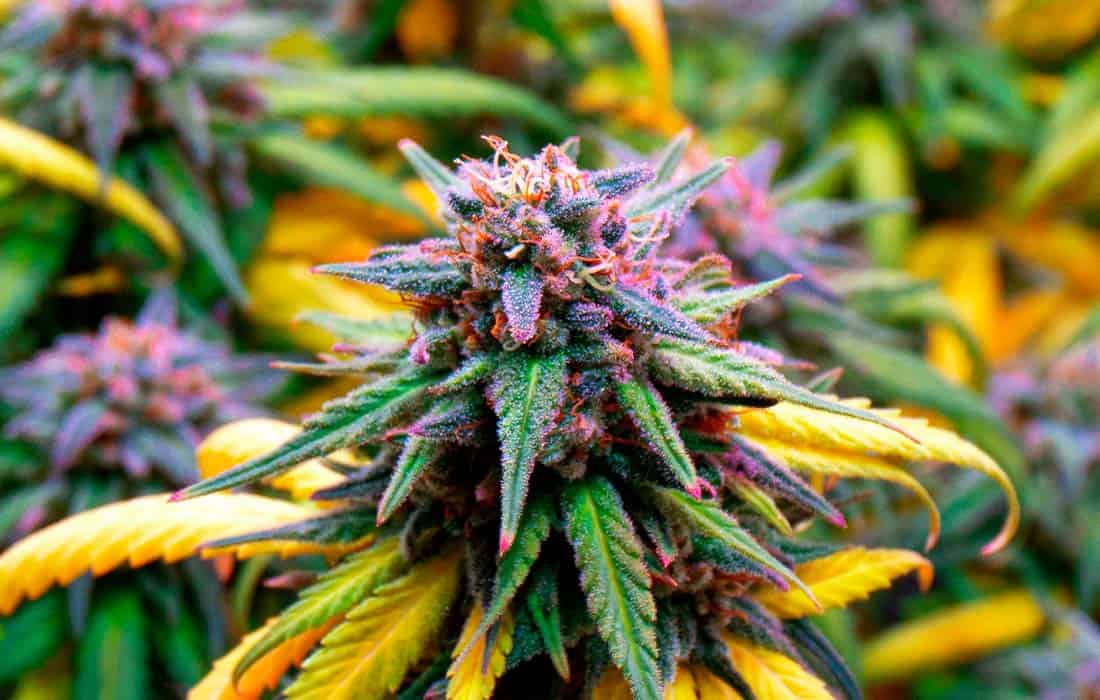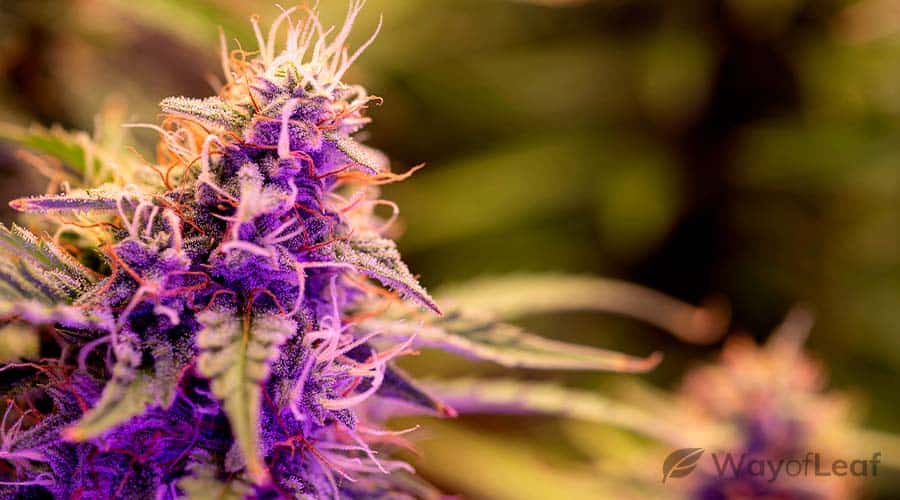There is no doubt that purple weed looks impressive. Many purple strains, such as Granddaddy Purple, have become world-famous due to their unusual color and potent mind-altering effects. But does being a different color mean that a particular strain will be more potent? Or be potentially more medicinally beneficial than others?
In this article, we will help you to separate the myths from the facts. We will discuss why weed turns purple and what that means for cannabis lovers around the world.
Why Does Weed Turn Purple?
Weed turns purple due to a high content of pigments called anthocyanins in their leaves. Anthocyanins are naturally occurring, water-soluble pigments found in many plants. They are the color pigments that make blueberries blue, blackberries black, and red grapes red.
They are also present in some cannabis strains. These anthocyanin pigments account for the variety of colors that appear in buds from different plants.
Anthocyanins do not just make weed purple. They can turn it into a variety of colors, including red, gold, dark green, blue, or black. The color of cannabis depends on the genetics of the plant itself and how it is grown. Certain conditions influence the actual color and stability of anthocyanin pigments. Temperature, light, pH, and structure all play influential roles.
Just as leaves change color in the fall, cannabis leaves can change color as the plant reaches maturity. If you imagine a cannabis plant growing in nature, this would also happen in fall as the temperature decreases and the nights become longer.
Cold temperatures cause chlorophyll to break down, and this is what allows the other glorious colors to shine through.
Some specific strains have naturally high anthocyanin levels. Under certain conditions, such as entering the “winter” cycle of flowering, these strains reveal their beautiful purplish hues. This natural occurrence is determined by a combination of the plant’s genetics and external environmental factors.

Parker Curtis and the award-winning team at Homegrown Cannabis Co. in Humboldt County, CA, have put together a free 5-part DIY growing series (along with step-by-step eBooks) that are changing the way people grow cannabis at home. Check out the 100% free online series (and even learn how to grow your own purple weed!) using the link below:
What Are Anthocyanins?
Anthocyanins belong to the flavonoid group of phytochemicals. Flavonoids are a type of plant chemical that is commonly found in fruits, vegetables, cereals, teas, and nuts. They are also abundant in cannabis plants, along with two other types of compounds: cannabinoids and terpenes.
As well as giving plants their vibrant colors, anthocyanins are also thought to have certain health benefits. According to Khoo et al., “Scientific studies, such as cell culture studies, animal models, and human clinical trials, show that anthocyanidins and anthocyanins possess antioxidative and antimicrobial activities, improve visual and neurological health, and protect against various non-communicable diseases.”
Flavonoids, including anthocyanins, have been reported to have anti-inflammatory and antioxidant effects. According to a 2010 study in the Review of Food Science and Technology, anthocyanins could potentially provide a wealth of benefits, including a role in protecting the heart and liver, improving vision, and helping to prevent obesity and diabetes.
Many plants with high anthocyanin contents have been used as herbal medicines for millennia. Ancient societies from North America, Europe, and China have taken advantage of these naturally occurring remedies in the past.
So, with this in mind, is purple weed better for you than the green stuff? Unfortunately, probably not. The digestive tract absorbs the majority of anthocyanins. Therefore, to notice any significant difference, you would have to eat a ton of edibles. Probably not the greatest idea!
How to Grow Purple Weed: Myths and Facts

There is a lot of different, sometimes conflicting, information out there on how to grow purple weed. It is not as simple as some people would make it sound. Do it wrong, and you could end up damaging your cannabis plants and ruining your yield. So, if you want to grow purple marijuana for yourself, you will need to know the facts.
FACT – You Need to Choose the Right Strain
Making weed turn purple is down to a combination of environment and genetics. Some strains of cannabis will easily turn a beautiful shade of purple. However, others will stay green, no matter how hard you try.
To successfully grow purple marijuana, choose a strain that is high in anthocyanins. Finding one that has “purple” in its name is a pretty good starting point. Other purple strains are less obviously named.
Some of the best purple cannabis strains include:
- Purple Haze
- Purple Kush
- Purple Trainwreck
- Granddaddy Purple
- Blueberry Kush
- Blackberry
MYTH – You Can Turn Weed Purple by Depriving It of Nutrients
Many people believe that cannabis leaves turn purple when the plant is stressed. Otherwise, they think that denying the plant nutrients, such as oxygen, carbon dioxide, and nitrogen, can force it to change color.
However, like people, plants need nutrients to survive. If you remove these, your plant will soon become sick and die.
FACT – Cannabis Can Turn Purple in the Cold
Cold breaks down chlorophyll and allows anthocyanins to become dominant, giving weed a purple hue. Exposing your cannabis plants to cold temperatures can make the leaves change color. But only if you have a strain that is genetically programmed to do so (see above).
You need to be very careful, as extreme cold will damage your plant, and could even cause it to die.
So, how do you make your weed turn purple? You need to gradually reduce the temperature during the dark cycle as your plants get close to harvest time. A nighttime temperature of 50°F/10°C is ideal, but reduce the temperature slowly to avoid shocking your plants. Monitor them carefully, and only do this just before harvesting. Keeping your plants cold for too long could reduce your yield.
If a strain is genetically predisposed to turn purple, it may well do this by itself, particularly if it is grown outdoors in temperate regions.
MYTH – You Can Turn Weed Purple by Freezing It
Although specific strains turn purple when exposed to cold conditions, don’t use flash freezing or ice water flushes. While these methods may change the plant’s color, experts don’t recommend them due to the risk they pose.
Sudden exposure to extreme cold will stress your plant. After all, how would you like it if someone suddenly dumped a bucket of ice water over your head? Plant stress could result in lower THC levels, which is not what you want. In the worst-case scenario, you could even kill your plants by doing this.
Therefore, you need to do it gradually and only towards the end of the flowering phase.
FACT – Your pH Levels Could Affect the Color of Your Weed
Anthocyanins display different colors when exposed to various pH levels. Acidic conditions (low pH) can turn them shades of red. Alkaline conditions (high pH) can make them look closer to blue. A neutral pH is more likely to result in a purple tone.
That said, the pH of your growing medium affects your plants in many other ways, too. It is essential to keep your pH within the recommended levels for your particular strain.
MYTH – You Can Dye Your Weed Purple with Food Coloring
Okay, you could try this if you wanted to, but why bother? If you’re intent on growing purple cannabis, this method will never give you the satisfaction that doing it correctly would.
Instead, focus your efforts on choosing a suitable purple strain. Then, set up your grow room or garden well. Next, you will need to gradually reduce the temperature as your plants begin to flower. A little extra thought and effort at the start of your grow will ensure that you reap the rewards later.
Why Does Weed Turn Purple? Final Thoughts
Certain strains of cannabis have a natural predisposition to turn purple under the right conditions. If you grow one of these strains, it will reward you with a stunning display of foliage come harvest time.
However, most strains cannot and will not ever turn purple, no matter how hard you try. In these cases, you are more likely to harm your plants than change their color. Therefore, it is better not to attempt to do so at all.
We are naturally attracted to anything different, and nobody can deny that purple weed is staggeringly beautiful. So, if you’re bored with green and feel like doing something different, why not give growing purple marijuana a try? Let us know how you get on!


![How to Use Neem Oil for Cannabis Plants [Organic Pest Control]](https://wayofleaf.com/wp-content/uploads/2020/07/wol-banner-neem-oil-for-cannabis-plants-640x225.jpg)

![8 Tips for Growing Hindu Kush Marijuana [Grower’s Guide]](https://wayofleaf.com/wp-content/uploads/2019/01/wol_growing-hindu-kush-marijuana-640x225.jpg)







